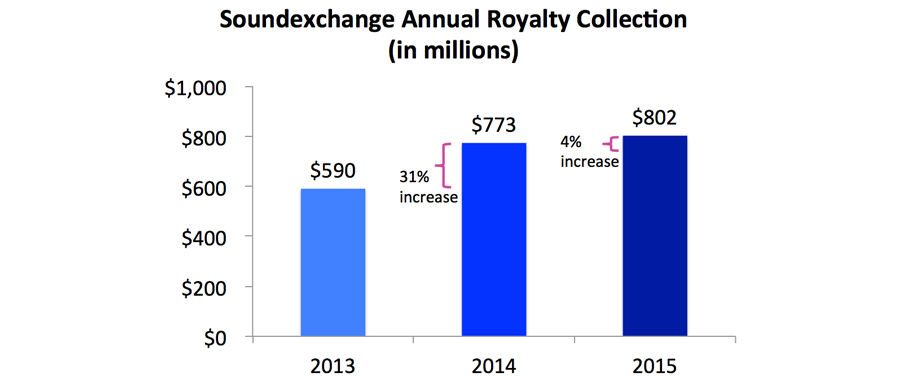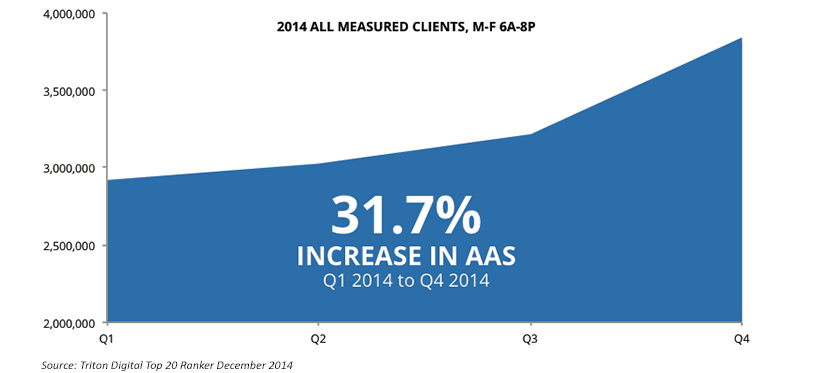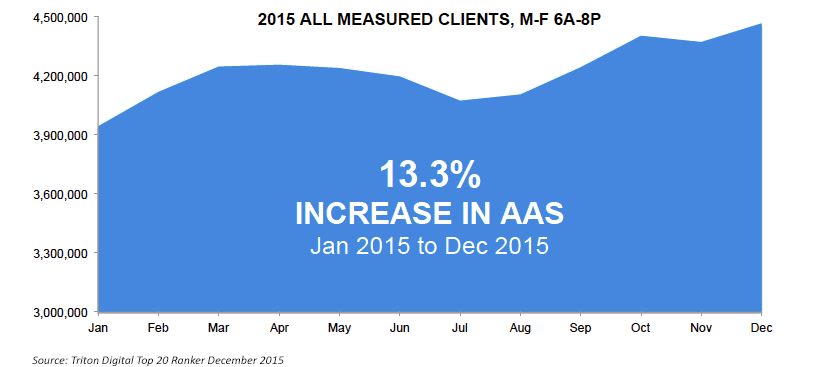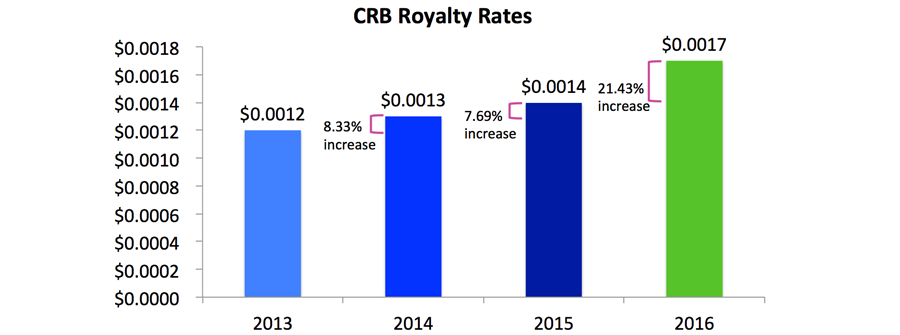Royalty payments are the single biggest cost for Internet radio and audio streaming services. In fact, the recent Copyright Royalty Board (CRB) decision to let the Webcaster Settlement Act of 2009 expire without comment was estimated to increase costs for small audio webcasters by 8-14 times. Large Internet radio services faced a still-high but more manageable 21% rise in royalty costs. All of these costs translate into revenue for artists after Soundexchange captures a processing fee for music played in the United States.
The question for observers of industry data is whether Soundexchange royalty collections are a good barometer of industry health and the revenue that Internet radio delivers to artists. The answer is that it is a single data point – and a large one – but is providing less insight than it once did.
The Soundexchange Growth Rate Decline
Soundexchange reports its annual royalty collections and the 2015 number topped $802 million. That was up only 4% from 2014 when the organization captured $773 million. The slow growth between 2014 and 2015 contrasts starkly with 2013 royalty collections of $590 million that delivered a 31% year-over-year increase for 2014.

Now, let’s compare that to another industry data point. Triton Digital’s Top 20 Ranker showed a growth rate in average active sessions (AAS)—by Internet radio listeners—of about 31% between year-end 2013 and 2014.

It could have been a coincidence that growth in the average number of active listeners closely matched the rise Soundexchange royalty payments that year, but if other variables were held constant, you’d expect a close correlation. However, we should at least account for the rise in CRB mandated royalty rates from $0.0012 to $0.0013 which is 8.33%. Add 8.33% to $590 million to get $639 million with no increase in listening. The 2014 rise to $773 million on royalties then translates into a 21% rise with other variables held equal. That is two-thirds of the rise in AAS.
This correlation is shattered with the revelation of 2015 numbers. Triton data from 2015 shows a 13.3% increase in AAS to complement the 4% rise in Soundexchange royalty collections.

During that period royalty rates climbed 7.69% from $0.0013 to $0.0014. If total Soundexchange eligible listening remained constant during 2015, we should expect an increase in royalty collections to $832 million. If Soundexchange then added two-thirds of the AAS listening increase, you would see a total of $906 million. So Soundexchange royalty collections actually come in 11.4% below expectations.

You can conclude from this analysis that Soundexchange while still a large source of artist royalty income is becoming relatively less important than other payment channels. You might also conclude that the 21% rise in royalty rates for 2016 should vault Soundexchage collections up past $970 million in this year. But, you’d probably be wrong. This rise in rates is so high that we should certainly expect a 2016 increase from Soundexchange, but migration of royalties and the disappearance of numerous small webcasters will likely suppress growth again. If those listeners go back to broadcast radio, then their listening time will be royalty free for recording artists which would mean a total loss of that revenue. Time will tell.
It is fair to say that there are many variables affecting the interrelationship between listening data and the total royalty revenue for the industry and that the math above ignores most of them. However, the changes are so stark that it is clear something is going on that the top line Soundexchange numbers do not adequately explain.
Where are the Royalty Payments Going?
The most likely destination for the migration of royalty payments are a shift to direct licensing contracts. These payments are not distributed through Soundexchange but instead are paid directly to rights holders. The 2015 focus on enlisting new subscribers may be one contributor to the change. In particular, Apple Music generated millions of new U.S. subscribers – both free trial and monthly payers – that may have previously listened to Internet radio. All of the streams of those listeners that previously generated royalty payments to Soundexchange would have shifted to direct payments to royalty holders by Apple.
The other thing that many people don’t realize is that music services like Spotify have direct contracts with labels for both their subscription and ad-supported streaming. None of these royalty payments go through Soundexchange. As a result, Spotify’s rapid rise in U.S. listeners has generated large royalty payments, but they are not captured in Soundexchange numbers.
The biggest impact going forward is likely to come from Pandora. In 2013 Pandora accounted for over 50% of Soundexchange royalty collections. However, in 2014 Pandora started executing direct licensing deals. The first was with Merlin which manages royalties for over 20,000 independent music labels. That deal alone, could have impacted Soundexchange’s collections in 2015. Since that time, Pandora has executed several direct licensing deals with numerous music publishers and has expressed an intent to secure deals with the major music labels that represent the top recording artists. If this intent takes effect, it could cut Soundexchange royalty numbers in half overnight, but it wouldn’t represent a fall in royalty payments to artists. The payments would simply be delivered through a different channel and may result in a net rise in revenue for music rights holders.
The Numbers Don’t Lie, Except When They Do
Don’t be surprised if you see articles quoting angry musicians lamenting the fall in Soundexchange royalties that insinuate music streaming services are somehow getting a free lunch at their expense. The emergence of these articles are a near certainty in 2017. But, they will be false. Music industry economics are wildly complicated and data about the total revenue is fragmented. The safe prediction today is that Soundexchange revenues are bound to decline over time despite a rise in royalty rates as streaming services migrate to direct contracts.
[su_button style=”flat” size=”6″ background=”#D73C90″ radius=”0″ url=”https://go.pardot.com/emailPreference/e/35552/300″ target=”_blank”]Subscribe to XAPP Blog[/su_button]
Related Posts
Royalty Rates Rise 21%, Quest for Higher Ad Rates Begins
RIAA Misleads While Advertising Delivers 54% of Internet Radio Revenue
New York Times Misled by Recording Industry on Internet Radio
